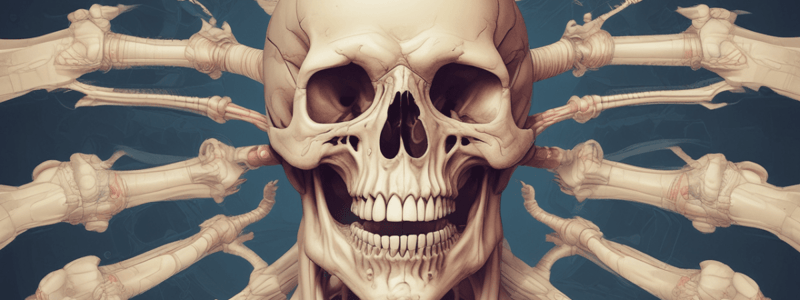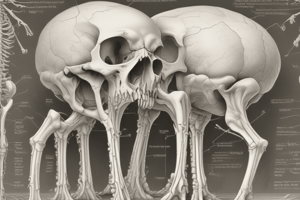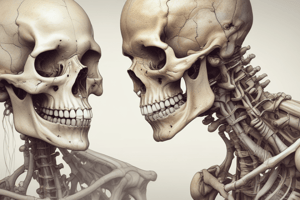Podcast
Questions and Answers
Which suture is NOT parallel to the others?
Which suture is NOT parallel to the others?
- Zygomatico-maxillary suture
- Frontozygomatic suture (correct)
- Pterygopalatine suture
- Zygomaticotemporal suture
What is the direction of growth at the zygomatico-maxillary suture?
What is the direction of growth at the zygomatico-maxillary suture?
- Horizontally from side to side
- Vertically from top to bottom
- From upward anteriorly to downward posteriorly (correct)
- From downward posteriorly to upward anteriorly
Which of the following contributes to the height of the maxilla?
Which of the following contributes to the height of the maxilla?
- Eruption of the upper permanent molars
- Alveolar process development (correct)
- Subperiosteal bone formation
- Enlargement of the maxillary sinus
What is the process called when the maxillary sinus expands?
What is the process called when the maxillary sinus expands?
What occurs at the floor of the nasal cavity during maxillary growth?
What occurs at the floor of the nasal cavity during maxillary growth?
What is the result of bone deposition on the oral surface of the palate?
What is the result of bone deposition on the oral surface of the palate?
What is the main function of the mandible?
What is the main function of the mandible?
What is the shape of the body of the mandible?
What is the shape of the body of the mandible?
When does the palato-facial center of ossification for the premaxilla appear?
When does the palato-facial center of ossification for the premaxilla appear?
What is the name of the second center of ossification for the premaxilla?
What is the name of the second center of ossification for the premaxilla?
At what stage of development does the maxilla articulate with the other bones of the skull by 4 main sutures?
At what stage of development does the maxilla articulate with the other bones of the skull by 4 main sutures?
What is the main location of the prevomerine center of ossification?
What is the main location of the prevomerine center of ossification?
When does the union between the maxilla and premaxilla occur?
When does the union between the maxilla and premaxilla occur?
What is the name of the suture that the maxilla articulates with?
What is the name of the suture that the maxilla articulates with?
What is the type of growth that continues till 10 years of age?
What is the type of growth that continues till 10 years of age?
Where do small areas of secondary cartilaginous centers appear?
Where do small areas of secondary cartilaginous centers appear?
What is the pathway through which the ossification spreads in the backward direction?
What is the pathway through which the ossification spreads in the backward direction?
What marks the point of divergence of the ramus of the mandible from Meckel's cartilage?
What marks the point of divergence of the ramus of the mandible from Meckel's cartilage?
What is the shape of the cartilage that appears in the region of the condyle?
What is the shape of the cartilage that appears in the region of the condyle?
What forms the posterior half of the ramus to the level of the inferior dental foramen?
What forms the posterior half of the ramus to the level of the inferior dental foramen?
When does the alveolar process start forming?
When does the alveolar process start forming?
What is the result of the growth of the bone of the mandible on each side of the tooth germ?
What is the result of the growth of the bone of the mandible on each side of the tooth germ?
What is the transient growth cartilage center that gives rise to the coronoid process?
What is the transient growth cartilage center that gives rise to the coronoid process?
What is the pathway through which the inferior dental nerve lies?
What is the pathway through which the inferior dental nerve lies?
What separates the mandibular canal from the bony crypts?
What separates the mandibular canal from the bony crypts?
How does the growth of the mandible occur?
How does the growth of the mandible occur?
What is the result of the growth of the mandible by secondary cartilages?
What is the result of the growth of the mandible by secondary cartilages?
At birth, what is the shape of the angle of the mandible?
At birth, what is the shape of the angle of the mandible?
What is the size of the mental foramen at birth relative to the socket of the first deciduous molar tooth?
What is the size of the mental foramen at birth relative to the socket of the first deciduous molar tooth?
What is the characteristic of the coronoid process at birth?
What is the characteristic of the coronoid process at birth?
What is the direction of the condyloid portion at birth relative to the body of the mandible?
What is the direction of the condyloid portion at birth relative to the body of the mandible?
What is the stage of growth during which the alveolar processes grow rapidly?
What is the stage of growth during which the alveolar processes grow rapidly?
At what age does the two segments of the mandible become joined at the symphysis?
At what age does the two segments of the mandible become joined at the symphysis?
What is the approximate angle of the mandible at birth?
What is the approximate angle of the mandible at birth?
What happens to the alveolar process in old age?
What happens to the alveolar process in old age?
What is the position of the mental foramen in adulthood?
What is the position of the mental foramen in adulthood?
What is the direction of the ramus in adulthood?
What is the direction of the ramus in adulthood?
What is the approximate angle of the mandible in adulthood?
What is the approximate angle of the mandible in adulthood?
What happens to the mandibular canal in adulthood?
What happens to the mandibular canal in adulthood?
What is the main change that occurs in the body of the mandible during childhood?
What is the main change that occurs in the body of the mandible during childhood?
What is the result of the growth of the alveolar part in childhood?
What is the result of the growth of the alveolar part in childhood?
What is the approximate angle of the mandible in childhood?
What is the approximate angle of the mandible in childhood?
What happens to the sub-dental portion of the mandible in childhood?
What happens to the sub-dental portion of the mandible in childhood?
Flashcards are hidden until you start studying
Study Notes
Development of the Premaxilla
- Premaxilla ossification occurs through two centers: the palato-facial center and the prevomerine (paraseptal) center.
- Palato-facial center appears by the end of 6 weeks, located above the lateral deciduous incisor germ, contributing to the inner wall of alveoli and the palatal part of the premaxilla.
- Prevomerine center begins at 8-9 weeks, forming beneath the anterior vomer and contributing to the nasal paraseptal cartilage.
- Union of maxilla and premaxilla occurs at 8 weeks of intrauterine life.
Accessory Cartilages
- Accessory cartilaginous centers develop in the future zygomatic process and undergo rapid ossification.
- Additional secondary cartilaginous centers form along the alveolar plate and midline of the hard palate.
Growth of the Maxilla
- Growth continues until approximately 10 years of age, primarily through sutural growth, alveolar development, and subperiosteal bone formation.
- Maxilla articulates with skull bones via four main sutures: fronto-maxillary, zygomatico-maxillary, zygomaticotemporal, and pterygopalatine.
- Eruption of permanent teeth, especially upper molars, enhances maxillary arch length.
- The maxillary sinus expands through bone resorption on the sinus side and deposition on the facial surface, a process known as pneumatization.
Development of the Mandible
- The mandible is the strongest facial bone, composed of a horizontal body and two ramus portions meeting at nearly right angles.
- Ossification spreads backward, forming a trough for the inferior dental nerve and eventually the mandibular canal.
- The ramus develops from mesenchyme of the first branchial arch, diverging from Meckel’s cartilage.
Mandibular Cartilages
- Condylar cartilage forms in the 12th week, shaping the condyle and posterior ramus half to the inferior dental foramen.
- Coronoid cartilage appears transiently, contributing to the coronoid process and the anterior ramus half.
Alveolar Process Formation
- The alveolar process initiates growth when deciduous tooth germs reach the early bell stage, forming a bony trough around tooth germs.
- Septa of bone develop between adjacent tooth germs, allowing the formation of the mandibular canal and supporting nerves and blood vessels.
Mandibular Growth Patterns
- Mandibular growth includes secondary cartilage contribution, especially from condylar cartilage, influencing height and overall length.
- Age-related changes occur in the mandible:
- At birth, the body is a simple shell accommodating various teeth; mental foramen opens below the first deciduous molar.
- In childhood, body elongation occurs, increasing depth for additional teeth and aligning the mental foramen and mandibular canal with growth.
- In adulthood, alveolar and sub-dental body depths are equal, with a nearly vertical ramus and narrower angle (110° to 120°).
- In old age, the mandible reduces in size, involving alveolar process absorption and repositioning of the canal and foramen.
Studying That Suits You
Use AI to generate personalized quizzes and flashcards to suit your learning preferences.




